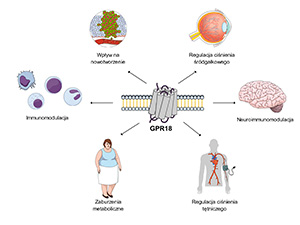GPR18 receptor – the structure and the role in the physiology and pathophysiology
DOI:
https://doi.org/10.18388/pb.2021_399Abstract
G-protein coupled receptors constitute the largest family of membrane receptors and they participate in the maintenance of the homeostasis in the body. Some of these receptors still remain orphan receptors as there is insufficient research and ambiguous evidence concerning their function and endogenous ligands. For a long time, GPR18 belonged to this group, but recently it has been classified as an endocannabinoid receptor due to its affinity to cannabinoid ligands. GPR18 receptor is expressed in the encephalon, thyroid gland, leukocytes, lungs and testicles. The modulatory role of GPR18 receptor has been proven in the regulation of intraocular pressure, neuroimmunomodulation, regulation of arterial blood pressure and in metabolic disorders. In this article we summarize the current knowledge concerning the GPR18 receptor – its expression, ligands and the in the physiological processes and the pathophysiological conditions.

Published
Issue
Section
License
Copyright (c) 2022 Michalina Jurkiewicz, Greta Steć, Adrian Szczepaniak, Jakub Fichna, Marta Zielińska

This work is licensed under a Creative Commons Attribution 4.0 International License.
All journal contents are distributed under the Creative Commons Attribution-ShareAlike 4.0 International (CC BY-SA 4.0) license. Everybody may use the content following terms: Attribution — You must give appropriate credit, provide a link to the license, and indicate if changes were made, ShareAlike — If you remix, transform, or build upon the material, you must distribute your contributions under the same license as the original. There are no additional restrictions — You may not apply legal terms or technological measures that legally restrict others from doing anything the license permits.
Copyright for all published papers © stays with the authors.
Copyright for the journal: © Polish Biochemical Society.



